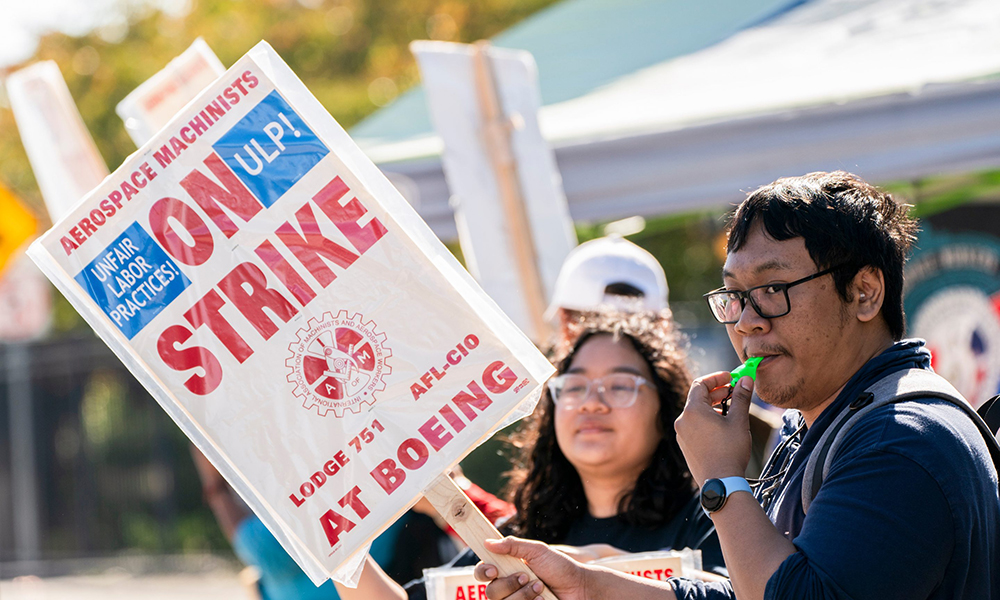
波音公司的飞机交付工作本就已经陷入迟滞,近一段时间更是几乎停摆。美银分析师指出,由于工人罢工仍在持续,波音飞机的延期交付问题变得愈发严峻。
上周日,美银分析师罗纳德·爱泼斯坦等人在一份报告中引用了飞机数据分析公司Aero Analysis Partners的公司数据称,截至10月中旬,波音只交付了一架737和一架787,另有一架737完成了客户验收飞行。本月,波音为中国航空公司生产的客机也没有任何一架完成验收飞行(波音预计要在未来20年内向中国交付8500架新飞机)。
美银表示,本月波音公司的交付量预计将在个位数,美银对波音仍保持中性平级。
此次交付延迟也充分说明了波音工人罢工的事态严重性。波音公司的3.3万名工人从9月13日开始罢工,他们的诉求是四年内要涨薪40%,并要求波音要在已经成立了工会的华盛顿工厂生产该公司目前尚未公开的新型商用飞机。这场持续一个月的罢工至少导致美国GDP损失10亿美元,并迫使波音公司考虑出售最多150亿美元新股以弥补罢工带来的损失。
罢工尤其影响了波音飞机的交付工作。当然,由于近年来的疫情、供应链和劳动力短缺等问题,波音的交付工作一直差强人意。波音公司上个月向《财富》证实,公司已经在成立了工会的华盛顿工厂停止了737 MAX、767、777/777X、P-8、KC-46A加油机和E-7“楔尾”预警机的生产。
波音公司的一位发言人表示:“我们在华盛顿和俄勒冈州的生产工厂也将暂停。未被工会代表的员工将正常上班。”
波音的“厄运循环”
早在这次罢工前,波音就已经噩运不断。先是今年1月,波音的一架737 MAX升空后机身突然破了一个大洞,从而招致联邦航空管理局的严厉调查。结果发现,波音的生产程序存在系统性失误。今年7月,波音前任CEO戴夫·卡尔霍恩于7月离职,由凯利·奥特伯格接替。奥特伯格曾任航空业巨头罗克韦尔柯林斯公司CEO。他之前已经退休了,这次又再次出山领导波音。
这次上任以后,奥特伯格采取了积极的行动来为波音“止血”,包括撤换了军工航天部门的负责人。他也采取了努力避免罢工,但最终事与愿违,上周,波音公司宣布将裁员10%,也就是大约17000名员工。
在10月11日发给员工的备忘录中,奥特伯格表示,波音将推迟其777X项目,并在交付剩余飞机后终止767货机的生产。
他表示:“我们需要把资源放在重要领域的业绩和创新上,而不是分散在太多不会带来好的成绩和投资的地方。”
对于波音来说,要想找到出路,并不是一件容易的事。爱泼斯坦此前在一份报告中就曾指出,波音公司已经为自己制造了一个“厄运循环”,非但没有灭火,而些点着了问题的火焰。
“波音每出现一个问题,还没等到解决,就有更多的问题冒出来。这些问题相互叠加,形成了一个持续的‘厄运循环’,加剧了负面影响。”
这对波音的客户们也是个坏消息,他们也感受到了波音工人罢工的影响。比如爱尔兰瑞安航空公司的CEO迈克尔·奥利里上月表示,由于波音罢工导致的停产问题,他预计到明年夏天前,他的公司将少接收5架飞机。波音原本承诺向瑞安航空交付30架飞机,但瑞安目前已经将预期下调到了25架。到了9月份,奥利里又表示,他预计到2025年夏季,瑞安航空可能将接收20架飞机左右。
奥利里表示,他“有信心”波音将在罢工后恢复元气。不过爱波斯坦也同,其他航空公司对波音则未必会像瑞安航空这样有耐心。
“近期事件对波音声誉造成的风险,可能会导致以后的订单增量减少。”他说。
波音和瑞安航空均未及时回应《财富》的置评请求。(财富中文网)
译者:朴成奎
波音公司的飞机交付工作本就已经陷入迟滞,近一段时间更是几乎停摆。美银分析师指出,由于工人罢工仍在持续,波音飞机的延期交付问题变得愈发严峻。
上周日,美银分析师罗纳德·爱泼斯坦等人在一份报告中引用了飞机数据分析公司Aero Analysis Partners的公司数据称,截至10月中旬,波音只交付了一架737和一架787,另有一架737完成了客户验收飞行。本月,波音为中国航空公司生产的客机也没有任何一架完成验收飞行(波音预计要在未来20年内向中国交付8500架新飞机)。
美银表示,本月波音公司的交付量预计将在个位数,美银对波音仍保持中性平级。
此次交付延迟也充分说明了波音工人罢工的事态严重性。波音公司的3.3万名工人从9月13日开始罢工,他们的诉求是四年内要涨薪40%,并要求波音要在已经成立了工会的华盛顿工厂生产该公司目前尚未公开的新型商用飞机。这场持续一个月的罢工至少导致美国GDP损失10亿美元,并迫使波音公司考虑出售最多150亿美元新股以弥补罢工带来的损失。
罢工尤其影响了波音飞机的交付工作。当然,由于近年来的疫情、供应链和劳动力短缺等问题,波音的交付工作一直差强人意。波音公司上个月向《财富》证实,公司已经在成立了工会的华盛顿工厂停止了737 MAX、767、777/777X、P-8、KC-46A加油机和E-7“楔尾”预警机的生产。
波音公司的一位发言人表示:“我们在华盛顿和俄勒冈州的生产工厂也将暂停。未被工会代表的员工将正常上班。”
波音的“厄运循环”
早在这次罢工前,波音就已经噩运不断。先是今年1月,波音的一架737 MAX升空后机身突然破了一个大洞,从而招致联邦航空管理局的严厉调查。结果发现,波音的生产程序存在系统性失误。今年7月,波音前任CEO戴夫·卡尔霍恩于7月离职,由凯利·奥特伯格接替。奥特伯格曾任航空业巨头罗克韦尔柯林斯公司CEO。他之前已经退休了,这次又再次出山领导波音。
这次上任以后,奥特伯格采取了积极的行动来为波音“止血”,包括撤换了军工航天部门的负责人。他也采取了努力避免罢工,但最终事与愿违,上周,波音公司宣布将裁员10%,也就是大约17000名员工。
在10月11日发给员工的备忘录中,奥特伯格表示,波音将推迟其777X项目,并在交付剩余飞机后终止767货机的生产。
他表示:“我们需要把资源放在重要领域的业绩和创新上,而不是分散在太多不会带来好的成绩和投资的地方。”
对于波音来说,要想找到出路,并不是一件容易的事。爱泼斯坦此前在一份报告中就曾指出,波音公司已经为自己制造了一个“厄运循环”,非但没有灭火,而些点着了问题的火焰。
“波音每出现一个问题,还没等到解决,就有更多的问题冒出来。这些问题相互叠加,形成了一个持续的‘厄运循环’,加剧了负面影响。”
这对波音的客户们也是个坏消息,他们也感受到了波音工人罢工的影响。比如爱尔兰瑞安航空公司的CEO迈克尔·奥利里上月表示,由于波音罢工导致的停产问题,他预计到明年夏天前,他的公司将少接收5架飞机。波音原本承诺向瑞安航空交付30架飞机,但瑞安目前已经将预期下调到了25架。到了9月份,奥利里又表示,他预计到2025年夏季,瑞安航空可能将接收20架飞机左右。
奥利里表示,他“有信心”波音将在罢工后恢复元气。不过爱波斯坦也同,其他航空公司对波音则未必会像瑞安航空这样有耐心。
“近期事件对波音声誉造成的风险,可能会导致以后的订单增量减少。”他说。
波音和瑞安航空均未及时回应《财富》的置评请求。(财富中文网)
译者:朴成奎
Boeing’s already sluggish aircraft delivery schedule has now screeched to a near halt. Bank of America analysts say the battered aircraft manufacturer is experiencing sharper delivery delays as a result of an ongoing strike against the company.
Citing data from aircraft data analyst Aero Analysis Partners, BofA analyst Ronald Epstein and colleagues said in a Sunday note that only one 737 jet and one 787 jet have been delivered as of mid-October. One other 737 has completed a customer acceptance flight, a test flight used to evaluate the function of the plane before it is delivered. No aircrafts expected to be delivered to Chinese airlines—where Boeing is expected to deliver 8,500 new planes over the next 20 years—have completed a customer acceptance flight this month.
BofA expects Boeing deliveries to hover in the single-digits this month and maintains a neutral rating of the airline.
The delivery standstill is a symptom of the ongoing strike of 33,000 workers that began on Sept. 13, with workers demanding a 40% wage increase over four years and that the company manufactures its yet-to-be-announced new commercial aircraft at its unionized Washington factory. The fallout from the monthslong strike has accounted for an estimated $1 billion reduction in the U.S. GDP and has forced Boeing to consider selling up to $15 billion of new stock to account for the losses.
The strike has been troubling for Boeing’s aircraft delivery schedule in particular, which has already been impaired for years due to pandemic-era supply-chain hiccups and labor shortages. Boeing confirmed to Fortune last month it halted aircraft production of the 737 MAX, 767, 777/777X, P-8, KC-46A Tanker, and E-7 Wedgetail at its unionized Washington plant.
“Work at our Fabrication sites in Washington and Oregon will also temporarily pause,” a Boeing spokesperson said. “Employees not represented by this union will continue to report to work as normal.”
Boeing’s ‘doom loop‘
Prior to the strike, Boeing was already reeling after a door plug blew off a 737 MAX in January that led to a scathing probe from the Federal Aviation Administration, which found systemic lapses in manufacturing procedures. Former CEO Dave Calhoun left the company in July, opening the door to new boss Kelly Ortberg, the former chief of aerospace giant Rockwell Collins, who emerged from retirement to lead the aircraft manufacturer.
Since his arrival, Ortberg has taken aggressive action to stop the bleeding at Boeing, including removing the head of its troubled defense and space division. His last-ditch effort to avoid a strike ultimately backfired, and the company announced last week it would slash 10% of its workforce, or about 17,000 employees.
In an Oct. 11 memo to employees, Ortberg said Boeing will delay its 777X program and conclude production of its 767 Freighters following the delivery of the remaining vehicles.
“We also need to focus our resources on performing and innovating in the areas that are core to who we are, rather than spreading ourselves across too many efforts that can often result in underperformance and underinvestment,” he said.
But finding a way out of its struggles is a steep undertaking. Epstein said in an earlier note that Boeing has created a “doom loop” for itself, fanning the flames of its problems instead of putting out the fires.
“For every problem that’s come to a head, then severed, more problems sprout up,” he said. “The issues all feed into each other, creating a continuous doom loop while compounding the negative impacts.”
This could spell bad news for Boeing’s airline customers feeling the effects of the strike. Ryanair CEO Michael O’Leary said last month he already anticipated five fewer aircrafts from Boeing by next summer because of strike-incited production halts. Originally promised 30 aircrafts, Ryanair lowered its expectations to 25 planes due to operational problems. As of September, O’Leary expected his airline will receive closer to 20 aircrafts by summer 2025.
O’Leary said he is “confident” Boeing will bounce back after the strike, but other airlines may not be as patient with the manufacturer, Epstein warned.
“Reputation risk stemming from recent incidents could result in fewer incremental orders,” he said.
Boeing and Ryanair did not immediately respond to Fortune’s requests for comment.






